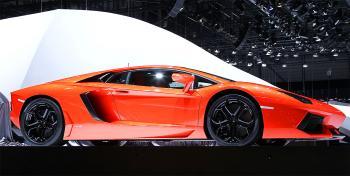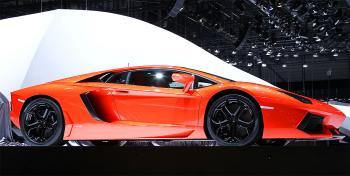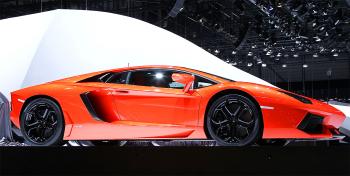This 700-bhp, four-wheel-drive brute is described by Lamborghini as “a new reference among super sports cars.”
“The Aventador is a jump of two generations in terms of design and technology,” says Stephan Winkelmann, President and CEO of Automobili Lamborghini on the company’s website. “It is extreme in its design and its performance, uncompromising in its standards and technology, and unmistakably Italian in its style and perfection.
“Overall, the dynamics and technical excellence of the Aventador LP 700-4 make it unrivaled in the worldwide super sports car arena.”
Bold words. Does the Aventador (named after a particularly brave fighting bull) really “redefine the pinnacle of the super sports car segment” as the company’s literature claims?
Lamborghini has produced tremendously fast cars since the firm’s founding in the early 60’s. Its models are legendary: the Miura, the Countach, the Diablo, the Murciélago. Does the Aventador even beat its predecessors?
That might be easier to quantify.
Compared to the lightest fastest Murciélago—the LP 670-4 SuperVeloce—the Aventador has a brand new, lighter and more powerful V12 engine, a lighter and faster shifting 7-speed transmission, a more advanced four-wheel-drive system, wrapped in a chassis that is more advanced and significantly stiffer, with a more compliant F1-inspired pushrod suspension. The Aventador is the most super Lamborghini supercar to date.
[etssp 264]
Carbon Fiber Monocoque, Pushrod Suspension
The new Lamborghini starts off with a carbon-fiber monocoque safety cell with front and rear aluminum subframes supporting the engine and suspension. Manufactured entirely in-house, the chassis weighs only 506 lbs.
Though light, the chassis is exceptionally stiff. Lamborghini claims a torsional stiffness of 35,000 newton-meters per degree, which compares quite favorably with the competition: the Pagani Zonda F at 27,000 Nm/deg, the Koenigsegg CC8 at 28,100 Nm/deg, and the Ferrari F50 at 34,600 Nm/deg.
Augmenting the stiff chassis is the pushrod suspension. Because the shocks and springs are mounted inboard on the chassis rather than directly attached to the suspension arms, the Aventador can use softer springs and more compliant shock settings. The stiffer mountings, coupled with the lower unsprung weight of the pushrod system, means the Aventador’s suspension can be more responsive while still coping with the tremendous forces involved.
Engine and Transmission
Of course, the heart of any supercar is the engine, and in a Lamborghini, that means a V-12. In the Aventador’s case, that means a brand new 6.5-liter fuel-injected V-12 developing 700 horsepower at 8,250 rpm, and 509 lb-ft of torque at 5,500 rpm.
This is the most powerful motor Lamborghini has ever offered in a production car. With electronic variable valve timing, multiple electronically-controlled intake paths to widen the torque curve, and four computers monitoring every aspect of engine function, this is also the most advanced engine Lamborghini has ever produced.
The engine is also smaller, lighter, and has a lower center of gravity than the Murciélago unit.
The transmission is equally advanced. Using a technology called Independent Shift Rods, this servo-actuated transmission can change gears in 50 milliseconds—about as fast as an F1 transmission. Where previous transmissions had to shift out of one gear and then into the next, the new ISR gearbox handles both tasks at once.
The new unit is exceedingly complex, using four shift rods, seven hydraulic valves, a high-pressure (870 psi) electric pump and multiple sensors telling the transmission’s electronic brain exactly where every piece is at all times. Yet the whole unit weighs only 156 lbs. By comparison, the Koenigsegg transmission, noted as the lightest until now, weighs 180.
The seven-speed, twin-clutch transmission feeds power to Lamborghini’s most advanced four-wheel drive system, which uses an electronic coupling to split power between the front and rear axles, with an electronic front differential dividing power between the two front wheels.
The power reaches the road through the expected enormous tires: Z-rated Pirellis, 255/35 ZR19 up front and 335/30 ZR20 in the rear. Traction shouldn’t be a problem.
Stopping all that power are equally enormous hydraulically-assisted ventilated carbon-composite brakes: 6-cylinder-per-caliper, 400-millimeter (15.75-inch)-diameter front brakes and 4-cylinder, 380-mm (15-inch) rears, all with ABS, of course.
Next: Style
Style
Inside the car, style hides safety while accentuating performance. Hidden in the all-leather interior are six airbags to protect passengers from every angle.Quite visible in the cockpit are two LCD screens which display a wealth of information. Instead of gauges in the dash, the screen there displays whatever information the driver deems most important, while the central screen handles entertainment, communications, and navigation.
The driver can choose between three driving modes: Strada, Sport, and Corsa. Each triggers the car’s electronics to adjust the suspension, steering, shifting and engine response for street, sport, or racing use.
Supercar styling is one area where measurements and facts have no meaning.






